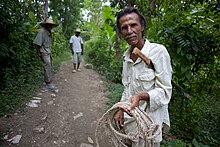Marabou (ethnicity)
 Marabou Haitian man | |
| Total population | |
|---|---|
| 590,000+[1] | |
| Regions with significant populations | |
| Haiti, United States, Canada, France[2] | |
| Languages | |
| French, Haitian Creole, French-based creole languages | |
| Religion | |
| Predominantly Roman Catholic, but also Anglican, Protestant, Baptist, Seventh-day Adventist Church and Jehovah's Witness | |
| Related ethnic groups | |
| Afro-Caribbeans, Dougla, Affranchi |
Marabou (/ˈmærəbu/; French: marabout) is a term of Haitian origin denoting Haitians of Mixed race ancestry. The term comes originally from the African Marabouts. Marabous are mainly descended from intermingling between Africans, Europeans and indigenous Taino.
The Marabou label dates to the colonial period of Haiti's history, meaning the offspring of a mulatto and a griffe person.[3][4] However, Médéric-Louis-Elie Moreau de Saint-Méry, in his three volume work on the colony,[5] describes Marabous as the product of the union of an African/European and a Taino.[5]
See also
[edit]- Mulatto Haitians
- Afro-Haitians
- White Haitians
- Indo-Haitians
- Chinese Haitians
- Zambo
- Indo-African (disambiguation)
- Dougla people
- Arab Haitians
- Italian Haitians
- French Haitians
- German Haitians
References
[edit]- ^ "Le marabout : Description, lieu de vie, alimentation, reproduction des marabouts".
- ^ "Home". Embassy of Haiti. Retrieved August 30, 2023.
- ^ John Stephen Farmer (1889). Americanisms--old & New. p. 377.
Mulatto. — A name given to the offspring of a white and a negro. The word is Spanish, mulato from mulo a mule or, as in ... meamelouc; Griffe | black, negro and mulatto; Marabou, § black, mulatto and griffe; Sacatra, g black, griffe and negro.
- ^ Enciclopedia universal ilustrada europeo-americana (in Spanish). Enciclopedia universal ilustrada europeo-americana. 1925. p. 533.
De este modo, el hijo de mulato y negra es un griffe, y el de griffe y negro unmarabou ó marabout y así sucesivamente.
- ^ a b Médéric-Louis-Elie Moreau de Saint-Méry. Description topographique, physique, civile, politique et historique de la partie francaise de lisle Saint-Domingue. 3 vols.(Philadelphia, 1797).


 French
French Deutsch
Deutsch